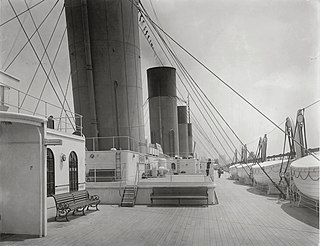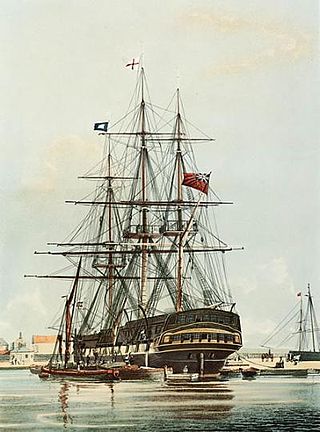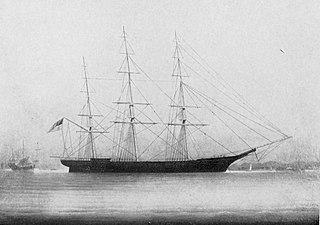Related Research Articles

Toilet humour, or potty or scatological humour, is a type of off-colour humour dealing with defecation, diarrhea, constipation, urination and flatulence, and to a lesser extent vomiting and other bodily functions. It sees substantial crossover with sexual humour, such as dick jokes.

In naval architecture, a poop deck is a deck that forms the roof of a cabin built in the rear, or "aft", part of the superstructure of a ship.

The forecastle is the upper deck of a sailing ship forward of the foremast, or, historically, the forward part of a ship with the sailors' living quarters. Related to the latter meaning is the phrase "before the mast" which denotes anything related to ordinary sailors, as opposed to a ship's officers.

A deck is a permanent covering over a compartment or a hull of a ship. On a boat or ship, the primary or upper deck is the horizontal structure that forms the "roof" of the hull, strengthening it and serving as the primary working surface. Vessels often have more than one level both within the hull and in the superstructure above the primary deck, similar to the floors of a multi-storey building, that are also referred to as decks, as are certain compartments and decks built over specific areas of the superstructure. Decks for some purposes have specific names.

Balclutha, also known as Star of Alaska, Pacific Queen, or Sailing Ship Balclutha, is a steel-hulled full-rigged ship that was built in 1886. She is representative of several different commercial ventures, including lumber, salmon, and grain. She is a U.S. National Historic Landmark and is currently preserved at the San Francisco Maritime National Historical Park in San Francisco, California. She was added to the National Register of Historic Places on 7 November 1976.

East Indiaman was a general name for any sailing ship operating under charter or licence to any of the East India trading companies of the major European trading powers of the 17th through the 19th centuries. The term is used to refer to vessels belonging to the Austrian, Danish, Dutch, English, French, Portuguese, or Swedish companies.

In naval architecture an afterdeck or after deck, or sometimes the aftdeck, aft deck or a-deck, is the open deck area toward the stern or aft back part of a ship or boat. The afterdeck can be used for a number of different purposes. Not all ships have an afterdeck. In place of the afterdeck a ship may be built with a poop deck, that is a deck that forms the roof of a cabin built in the rear, or "aft", part of the superstructure of a ship. A poop deck usually is higher up than an afterdeck. A ship may have its superstructure or aftercastle located in the stern and thus not have an afterdeck. The stern and afterdeck of a ship are usually more smooth and stable than the bow (front) of the ship in motion. A taffrail is the handrail around the open afterdeck or poop deck. On wooden sailing ships like man-of-war or East Indiaman the taffrail is usually a hand carved wood rail and often highly decorated.

Carry On Jack is a 1964 British comedy film, the eighth in the series of 31 Carry On films (1958–1992). Most of the usual Carry On team are missing from this film: only Kenneth Williams and Charles Hawtrey appear throughout, with Jim Dale making a cameo appearance as a sedan chair carrier. Bernard Cribbins makes the first of his three appearances in a Carry On. Juliet Mills, Donald Houston and Cecil Parker make their only Carry on appearances in this film. Carry On Jack was the second of the series to be filmed in colour and the first Carry On film with a historical setting and period costumes.

Yoho Ahoy is a 2000–01 British animated children's television series about a group of pirates, known as Yohos, who live on board their big pirate ship, The Rubber Duck. The title of the show derives from the fact that the only words the main characters say, depending on their feelings are "Yoho" and "Ahoy", that is a language. The characters themselves are animated puppets. In Spring 2001, the show itself won the Banff Television Festival Rockie Award: Best Animation for "Yoho Ahoy: Buzz with Jones". The show was first broadcast on CBBC and later on CBeebies in the United Kingdom, while in Canada, the programme aired on Knowledge Network.
Pirates of the Caribbean is an American fantasy supernatural swashbuckler film series produced by Jerry Bruckheimer and based on Walt Disney's theme park attraction of the same name. The film series serves as a major component of the eponymous media franchise.

Those Scurvy Rascals is a children's animated series following the adventures of three underwear obsessed pirates. First aired by Nickelodeon UK in May 2005, it is now broadcast worldwide. The main characters Sissy Le Poop, Smelly Pete and Shark Bait all live on the ship called "The Soiled Pair" and go on a different random adventure in every episode. The series was developed and produced by Blue-Zoo Productions and is owned by Entara.

Charles John Joughin was a British-American chef, known as being the chief baker aboard the RMS Titanic. He survived the ship's sinking, and became notable for having survived in the frigid water for an exceptionally long time before being pulled onto the overturned Collapsible B lifeboat with virtually no ill effects.

HMS Bedford was a 70-gun third rate ship of the line of the Royal Navy, launched at Woolwich Dockyard on 12 September 1698. She carried twenty-two 24-pounder guns and four (18-pounder) culverins on the lower deck; twenty-six 12-pounder guns on the upper deck; fourteen (5-pounder) sakers on the quarter-deck and forecastle; and four 3-pounder guns on the poop or roundhouse.
Poop is the solid or semisolid remains of the food that could not be digested in the small intestine. As a verb, it refers to defecation.

A Slice of Reality is a work of modern art by Richard Wilson sitting by the Millennium Dome on the north-western bank of the Greenwich Peninsula. It consists of a 9-metre (30 ft) sliced vertical section through the former 800-ton 60-metre (200 ft) sand dredger Arco Trent and exposes portions of the former living quarters of the vessel to the elements.

Pirates of the Caribbean: Dead Men Tell No Tales is a 2017 American swashbuckler fantasy film directed by Joachim Rønning and Espen Sandberg. It is written by Jeff Nathanson, from a story by Nathanson and Terry Rossio. Produced by Jerry Bruckheimer and distributed by Walt Disney Studios Motion Pictures, the film is the standalone sequel to On Stranger Tides (2011) and the fifth installment in the Pirates of the Caribbean film series. The film stars Johnny Depp, Javier Bardem, Geoffrey Rush, Brenton Thwaites, Kaya Scodelario, and Kevin McNally. The story follows Captain Jack Sparrow (Depp) searches for the Trident of Poseidon to defeat Armando Salazar (Bardem), who is determined to kill every pirate at sea and take revenge on Sparrow for imprisoning him and his crew of ghosts in the Devil's Triangle. Jack is joined by Hector Barbossa (Rush), Will Turner's son Henry (Thwaites), young astronomer Carina Smyth (Scodelario) and Jack's first mate Joshamee Gibbs (McNally) to defeat Salazar's ghostly crew.
TSS Ipswich was a passenger vessel built for the Great Eastern Railway in 1883.
In naval architecture, a taffrail is the handrail around the open deck area toward the stern of a ship or boat. The rear deck of a ship is often called the afterdeck or poop deck. Not all ships have an afterdeck or poop deck. Sometimes taffrail refers to just the curved wooden top of the stern of a sailing man-of-war or East Indiaman ship. The rails of these wooden sailing ships usually had hand-carved wooden rails, often highly decorated. Sometimes taffrail refers to the complete deck area at the stern of a vessel.

Gravina was an 818-register ton clipper ship built in Hoboken, New Jersey, in 1853. A rare example of a clipper built in the United States for foreign owners, Gravina was originally homeported in Spain, though commanded by an American.

A zabra (zah-brə) was a small or midsized sailing vessel used off the coasts of Spain and Portugal to carry goods by sea from the 13th century until the mid-16th century; they were well-armed to defend themselves against pirates and corsairs.
References
- 1 2 "TALES FROM THE POOP DECK". Archived from the original on 20 November 2004. Retrieved 18 February 2010.